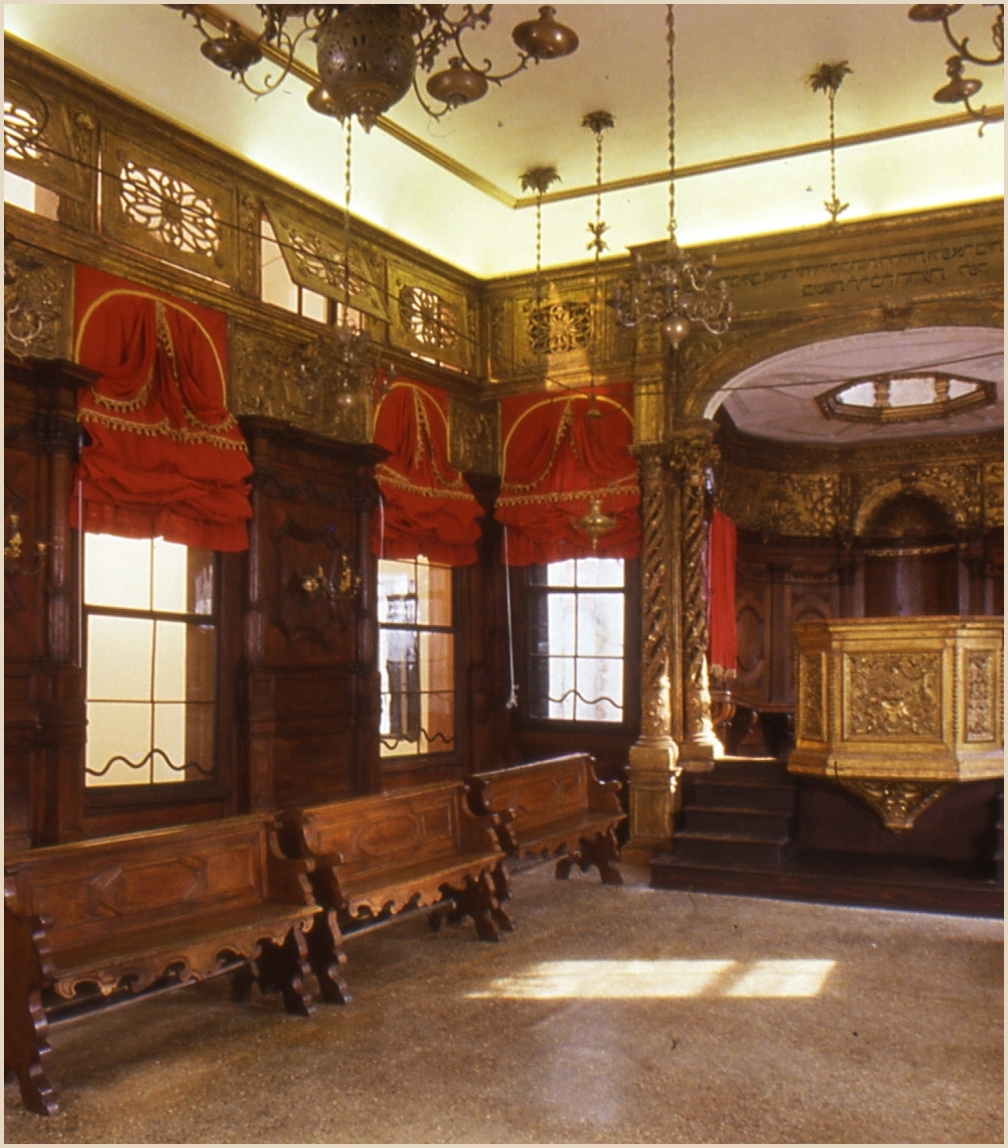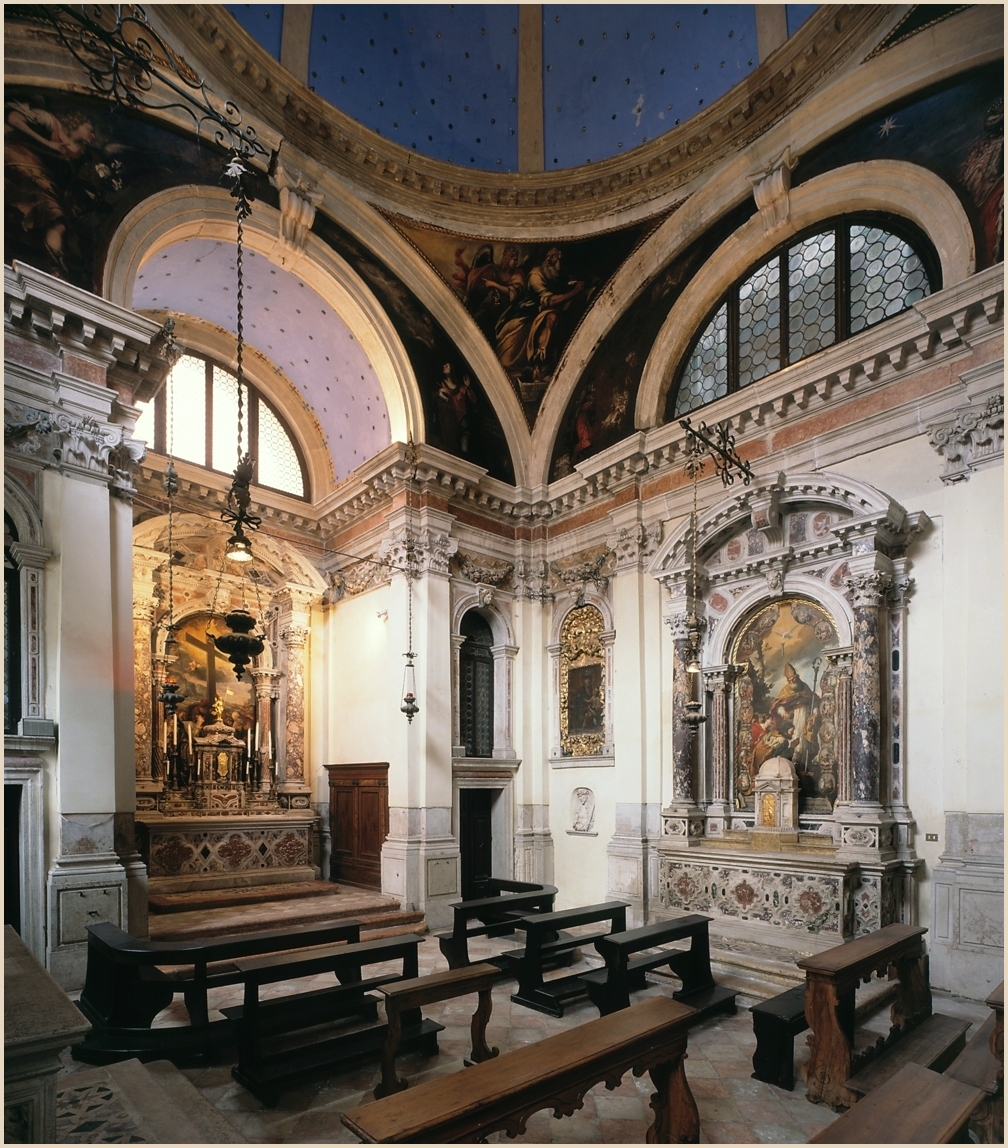|
Vittore Carpaccio, Calling of Matthew, Scuola dalmata |
Situated at the commercial crossroads between the flourishing markets of Europe and the exotic emporiums of Asia, Venice was a natural meeting point for both peoples and cultures, and it emerged as Europe's most cosmopolitan center.
In A City of Nations, you’ll enter into the tiny worlds created by the many ethnic groups that populated the Mediaeval and Renaissance city to discover how they lived and worked and learn the various economic, political, and religious forces that brought them to Venice. Throughout the guided tour, you'll also discover the impact of their new cultural environs on their religious convictions and artistic traditions.

Canton synagogue
in the New Ghetto
Beginning at the former German Exchange, we’ll see how the Venetian government viewed the many foreigners in the city and how transient merchants actually lived and conducted business inside the Exchange. We’ll then set off for the Jewish Ghetto where the gilded synagogues, the former pawn shops, and the cramped living quarters all await you. Along the way, we’ll discuss some of the many issues raised by the presence of the foreigners: the repression of heretical beliefs, the economic concessions made to skilled immigrant artisans, and the commercial privileges reserved for the Venetian citizenry among others. We’ll then relive the moment of economic and military crisis that led to the segregation of the city’s Jewish population and recreate day-to-day life inside the Ghetto when Christian printers published authoritative Hebrew commentaries and Jews from throughout Europe came to study with Venice’s learned rabbis. Next, it’s off to the Turkish Exchange where we’ll talk about the commercial relationships between Venice and its nemesis during times of war and about the problems of public order created by the presence of Turkish merchants in the city. At the church of the Holy Cross, we’ll then relive the saga of the Armenian people before traveling to the Dalmatian School, religious and cultural heart of the community that rendered hundreds of years of faithful service to the Venetian Republic. Our walking tour will then conclude at the church of Saint George of the Greeks where we'll immerse ourselves in the mysticism of the Near East. Retracing the history of the city’s all-important Greek community from the exodus of the first artisans at the time of the iconoclastic crisis up until the loss of Venice’s Greek colonies, we’ll also talk about its fundamental role in the diffusion of classical culture throughout Renaissance Europe.

Santa Croce degli Armeni
DURATION
Approximately 6 hours (including interior visit to the Jewish synagogues)
- Depending upon availability, it is also possible to divide the guided tour over two half-days.
MAJOR SIGHTS
- German Exchange (exterior)
- Jewish Ghetto
- Turkish Exchange (exterior)
- Dalmatian School
- works by Vittore Carpaccio - Church of Saint George of the Greeks
- works by Michail Damaskinos - Church of the Holy Cross of the Armenians (private visit)
- works by Andrea Celesti, Pietro Liberi, and Gregorio Lazzarini
ENGAGING TOPICS
- Heretics, schismatics, and infidels: economic integration and religious isolation
- Transient foreigners: sojourn permits and the policing of the State
- De intus et extra: the road to citizenship
- The Venetian press in Europe: culture and faith in the Jewish, Armenian, and Greek diasporas
- Apologetics: the justification of cultural differences
- ‘Turcherie’: the fashion for a declining foe
- The Veneto-Cretan icon: Eastern faith meets Western art
AVAILABILITY
This guided walking tour is not available in its entirety on Saturday and Sunday and on all Jewish and Christian holidays.
COST
The price indicated for this private guided cultural tour is intended to cover the costs of the Society’s continued research initiatives and organization and is in compliance with the conditions concerning the activities of non-profit organizations as set forth in the Ministry of Finance Unified Code Article 148, paragraph 3 (T.U. Art. 148, comma 3).
- Price: €340.00 (euro) for two (2) persons. Each additional adult costs €60.00. Minors under the age of 18 cost €30.00 each. Incidental transportation costs and entrance fees are not included.
SPECIAL NOTE
The private visit to the Armenian church cannot be confirmed prior to arrival in Venice.
SUGGESTED READING
To help make this guided history tour of Venice a culturally enriching and educational experience, these books are recommended.
Reviews of
A City of Nations
We were introduced to the many arriving cultures and peoples and to how they lived side by side and, on occasion, atop one another. Venice was a city full of Greeks, Slavs, Germans, Turks, Jews, and Italians from everywhere else, and its culture is a hotchpot of each of these groups. For someone to be able to convey to the uninitiated the differences is a wonder, and we are richer for it.
|
Scott Clarkson |
Single-handedly the most gratifying organized touring experience my wife and I have ever had! The tour was very focused on the various transient and permanent foreigners present throughout Venetian history. At the same time we learned so much information about the overall history of Venice and of the foreign populations. The guide’s knowledge of history seemed boundless, and his insights on politics, economics, and religion were fascinating. Yet the guide was rigorous in pointing out the distinction between facts and his own interpretations and suspicions. He truly had an uncanny ability to tie in all aspects together to paint a beautiful and comprehensive picture of Venice and its peoples. The private visits the Church of the Holy Cross of the Armenians and the Church of Saint George of the Greeks are over the top and make any trip to Venice truly unique.
|
Tom and Aleks Sufleta |
A wonderful glimpse back at the groups of people who came to Venice and at each group's impact on the history of the city. The neighborhoods, churches, and synagogues were both fascinating and awe-inspiring. Without this in-depth tour, we would have missed a very important part of the story of Venice.
|
Steve and Nancy Wiley |
Absolutely fascinating! “A City of Nations” is essential to understand what made Venice such an international city and how differing cultures and faiths interact, clash, or simply coexist. I was especially interested in the Jewish Ghetto with its remaining synagogues. But I discovered to my delight that there were equally fascinating treats in store — the Scuola di san Giorgio degli Schiavoni, one of the city's missed artistic jewels, opened my eyes to the contributions of the Dalmatians to the greatness and glory of Venice whilst the private visit to the Armenian church proved another of the day's highlights.
|
Amy Selwyn |
The scholarship required to plan this tour is astounding. I was especially moved by the depth of treatment and information about the Ghetto.
|
Eleanor Gilpatrick |
Very moving as well as educational. Our fellow travelers expressed great disappointment to have missed out on experiencing such an important part of local as well as world history. Standing in the square of the first ghetto was a moving moment. Following along from there to learn the history and experiences of other ethnic groups was important in understanding the “soul” of Venice.
|
Pete and Lorelei Redding |
Full of fascinating information about the development of the city by various groups.
|
Paul Stark and Susan Ulick |
For further information about this unique guided
cultural tour of Venice
and reservations, write to
To share